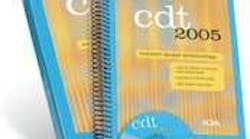By Mary Govoni, CDA, RDA, RDH, MBA
One of the most frequently utilized systems in a dental practice is the CDT (Current Dental Terminology) code on dental procedures and nomenclature. Given that this code system is used to describe, document, and bill for dental treatment every day, I am continually surprised that many practices are not aware of or using the current codes, or are incorrectly using some codes.
Prior to the implementation of HIPAA, the CDT was not updated frequently. In addition, many dental benefits providers utilized their own internal or company-specific codes for billing and payment of procedures. One of HIPAA’s purposes was to standardize the coding of dental or medical procedures. This directive prompted the updates to the coding system that we experienced over the past several years. The current code set for dental procedures is the CDT-2005, which will be updated every two years, in the odd years. This means that CDT-2007 will be released by the end of this year, to be used starting in 2007. If your practice is not utilizing the current codes and/or doesn’t have a copy of CDT-2005, you can purchase a copy from the American Dental Association (ADA) at www.ada.org/prod/catalog/cdt or by calling the ADA at (800) 947-4746.
The CDT-2005 is a valuable resource to dental teams, containing a glossary of terms and detailed descriptions of the codes, instructions for completing claim forms, and answers to common questions regarding proper coding of procedures. It is very important to review the code set you have input into your practice-management software to make sure it is up-to-date. In some cases, your software company may provide this as an update service for you.
Some of you may ask why the codes are so important. In terms of billing and insurance reimbursement, some assume that the insurance companies will just change the codes to the current ones if you use the old codes. In some cases, this may be true. It is the legal responsibility, however, of every dentist and dental practice to accurately describe and record the treatment provided for patients. This includes using currently accepted codes. Coding is not just for insurance billing. A coding system provides us with a universal language for documentation of treatment. Certainly there are special circumstances surrounding treatment for some patients, and these must be documented. For the most part, though, we follow standardized treatment protocols, which should be reflected in our coding procedures.
Always remember that just because a code exists for documentation of procedures doesn’t mean that insurance companies will reimburse for that procedure. For example, the code D1204 is for topical fluoride application - adult - prophy not included. Few insurance companies will pay for this procedure for adults, but many will for children. Keep in mind, however, that the lack of reimbursement from insurance should not prevent you from recommending this valuable treatment to your patients.
It is also important to remember that insurance companies may process claims under an alternate code that is consistent with their reimbursement policy. For example, if the policy will reimburse for amalgam restorations on posterior teeth, the payor will process claims for posterior composites under the code for amalgam. The dental practice must, however, code the procedure according to the procedure performed, regardless of the payment policy. Pay special attention to the codes that require a report or narrative. Failing to submit this information with a claim can delay payment or result in rejection of a claim.
For assistance with claims processing issues, there are several excellent resources available. The first is Insurance Solutions Newsletter, a bimonthly publication from American Dental Support, LLC. This newsletter has up-to-date, practical information on managing insurance claims and reimbursements, as well as interpretations of the changes to the CDT. Information about Insurance Solutions is available at www.dental-ins-solutions.com. Another great resource is Trojan Professional Services, which has several products and services available, including a computerized database of insurance plans and benefits. Since most patients are not aware of the provisions of their plans, it is very helpful to have this information readily accessible. Information about Trojan’s services is available at www.trojanonline.com.
In your practice-management software, you can maximize the use of the CDT by posting insurance payments by the code rather than in a batch payment. For example, a payment that is received for a recare visit (periodic exam, prophylaxis, and bitewings) should be posted in three entries, one for each procedure. The value of taking the time to post this way is that each time a payment is posted, the benefits database in your system is updated. This allows you to better estimate future payments for that patient or other patients with the same plan.
Hopefully you are up-to-date in your coding procedures, perhaps just in time for the introduction of CDT-2007. You may not be aware that you can submit comments on the current CDT, to be considered for the next release. If you have suggestions for new codes or changes to the codes that you would like considered for the new CDT, submit your comments to the ADA at www.ada.org/goto/dentalcode. And watch for announcements from the ADA on the release of CDT-2007.
Mary Govoni is a certified and registered dental assistant and a registered dental hygienist with more than 34 years of experience in the dental profession as a chairside assistant, office administrator, clinical hygienist, educator, consultant, and speaker. She is the owner of Clinical Dynamics, a consulting company dedicated to the enhancement of the clinical and communication skills of dental teams. She can be reached at [email protected].







